tire type PONTIAC VIBE 2009 Owners Manual
[x] Cancel search | Manufacturer: PONTIAC, Model Year: 2009, Model line: VIBE, Model: PONTIAC VIBE 2009Pages: 318, PDF Size: 1.53 MB
Page 118 of 318
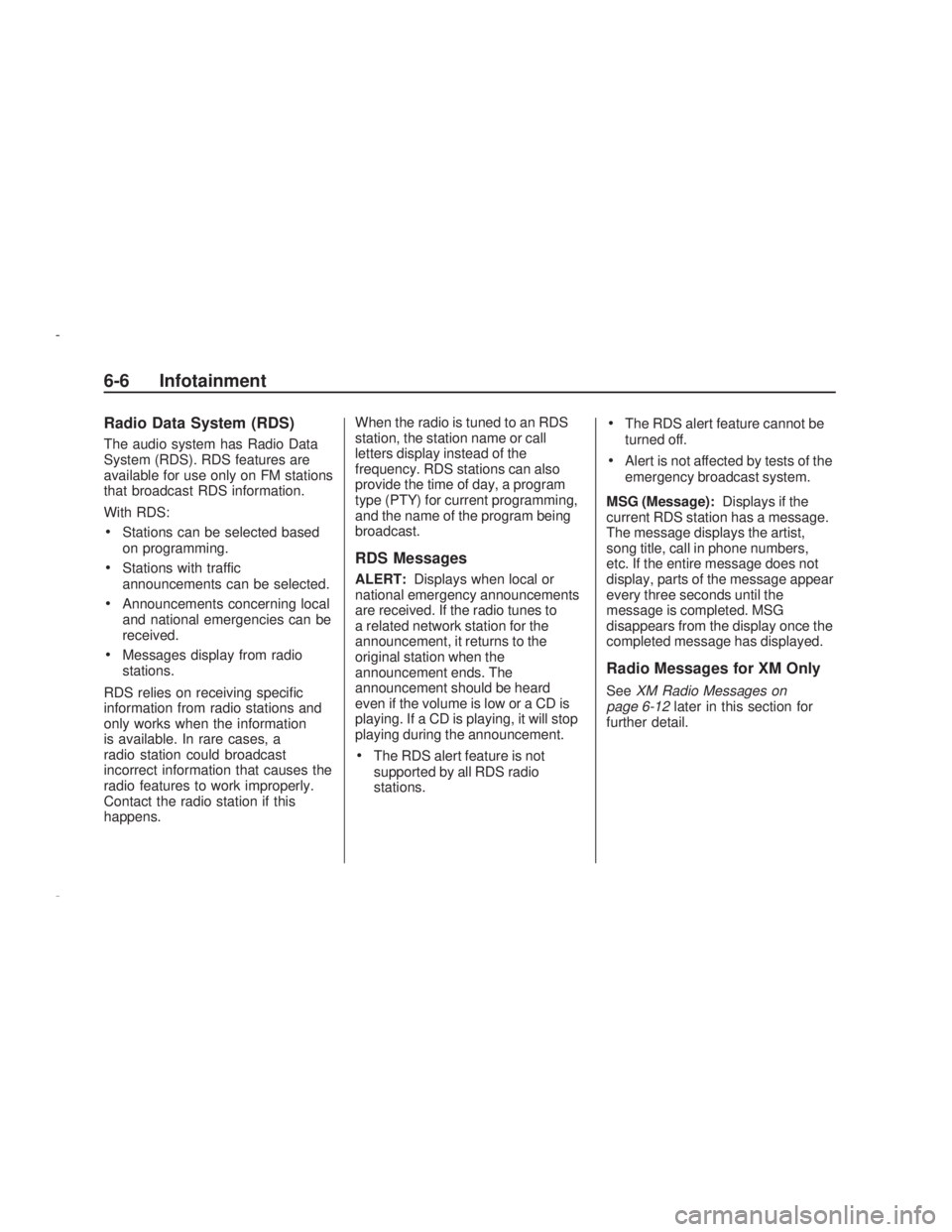
Radio Data System (RDS)
The audio system has Radio Data
System (RDS). RDS features are
available for use only on FM stations
that broadcast RDS information.
With RDS:
Stations can be selected based
on programming.
Stations with traffic
announcements can be selected.
Announcements concerning local
and national emergencies can be
received.
Messages display from radio
stations.
RDS relies on receiving speci�c
information from radio stations and
only works when the information
is available. In rare cases, a
radio station could broadcast
incorrect information that causes the
radio features to work improperly.
Contact the radio station if this
happens.When the radio is tuned to an RDS
station, the station name or call
letters display instead of the
frequency. RDS stations can also
provide the time of day, a program
type (PTY) for current programming,
and the name of the program being
broadcast.
RDS Messages
ALERT:Displays when local or
national emergency announcements
are received. If the radio tunes to
a related network station for the
announcement, it returns to the
original station when the
announcement ends. The
announcement should be heard
even if the volume is low or a CD is
playing. If a CD is playing, it will stop
playing during the announcement.
The RDS alert feature is not
supported by all RDS radio
stations.
The RDS alert feature cannot be
turned off.
Alert is not affected by tests of the
emergency broadcast system.
MSG (Message):Displays if the
current RDS station has a message.
The message displays the artist,
song title, call in phone numbers,
etc. If the entire message does not
display, parts of the message appear
every three seconds until the
message is completed. MSG
disappears from the display once the
completed message has displayed.
Radio Messages for XM Only
SeeXM Radio Messages on
page 6-12later in this section for
further detail.
6-6 Infotainment
2009 - Pontiac Vibe Owner Manual
Page 157 of 318
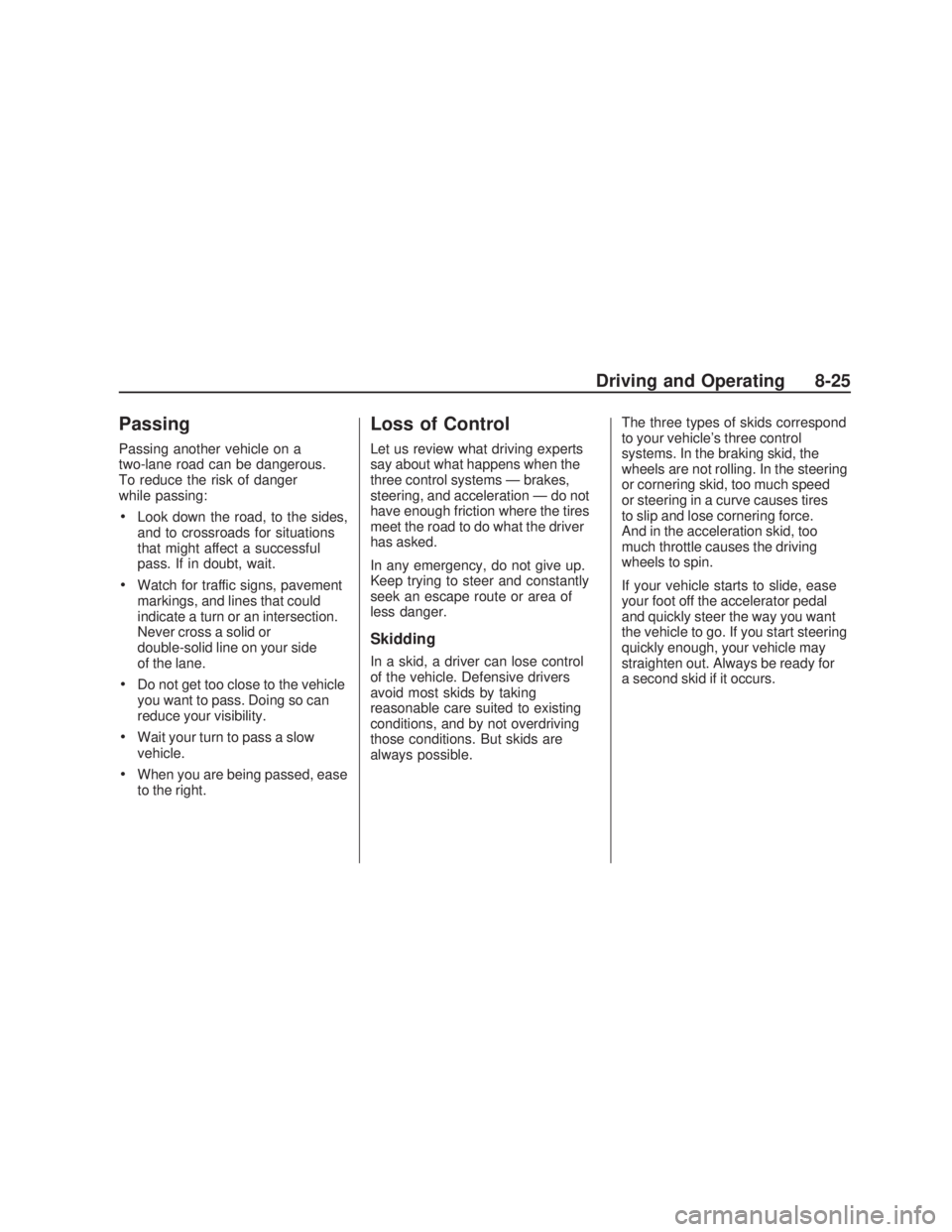
Passing
Passing another vehicle on a
two-lane road can be dangerous.
To reduce the risk of danger
while passing:
Look down the road, to the sides,
and to crossroads for situations
that might affect a successful
pass. If in doubt, wait.
Watch for traffic signs, pavement
markings, and lines that could
indicate a turn or an intersection.
Never cross a solid or
double-solid line on your side
of the lane.
Do not get too close to the vehicle
you want to pass. Doing so can
reduce your visibility.
Wait your turn to pass a slow
vehicle.
When you are being passed, ease
to the right.
Loss of Control
Let us review what driving experts
say about what happens when the
three control systems — brakes,
steering, and acceleration — do not
have enough friction where the tires
meet the road to do what the driver
has asked.
In any emergency, do not give up.
Keep trying to steer and constantly
seek an escape route or area of
less danger.
Skidding
In a skid, a driver can lose control
of the vehicle. Defensive drivers
avoid most skids by taking
reasonable care suited to existing
conditions, and by not overdriving
those conditions. But skids are
always possible.The three types of skids correspond
to your vehicle’s three control
systems. In the braking skid, the
wheels are not rolling. In the steering
or cornering skid, too much speed
or steering in a curve causes tires
to slip and lose cornering force.
And in the acceleration skid, too
much throttle causes the driving
wheels to spin.
If your vehicle starts to slide, ease
your foot off the accelerator pedal
and quickly steer the way you want
the vehicle to go. If you start steering
quickly enough, your vehicle may
straighten out. Always be ready for
a second skid if it occurs.
Driving and Operating 8-25
2009 - Pontiac Vibe Owner Manual
Page 159 of 318
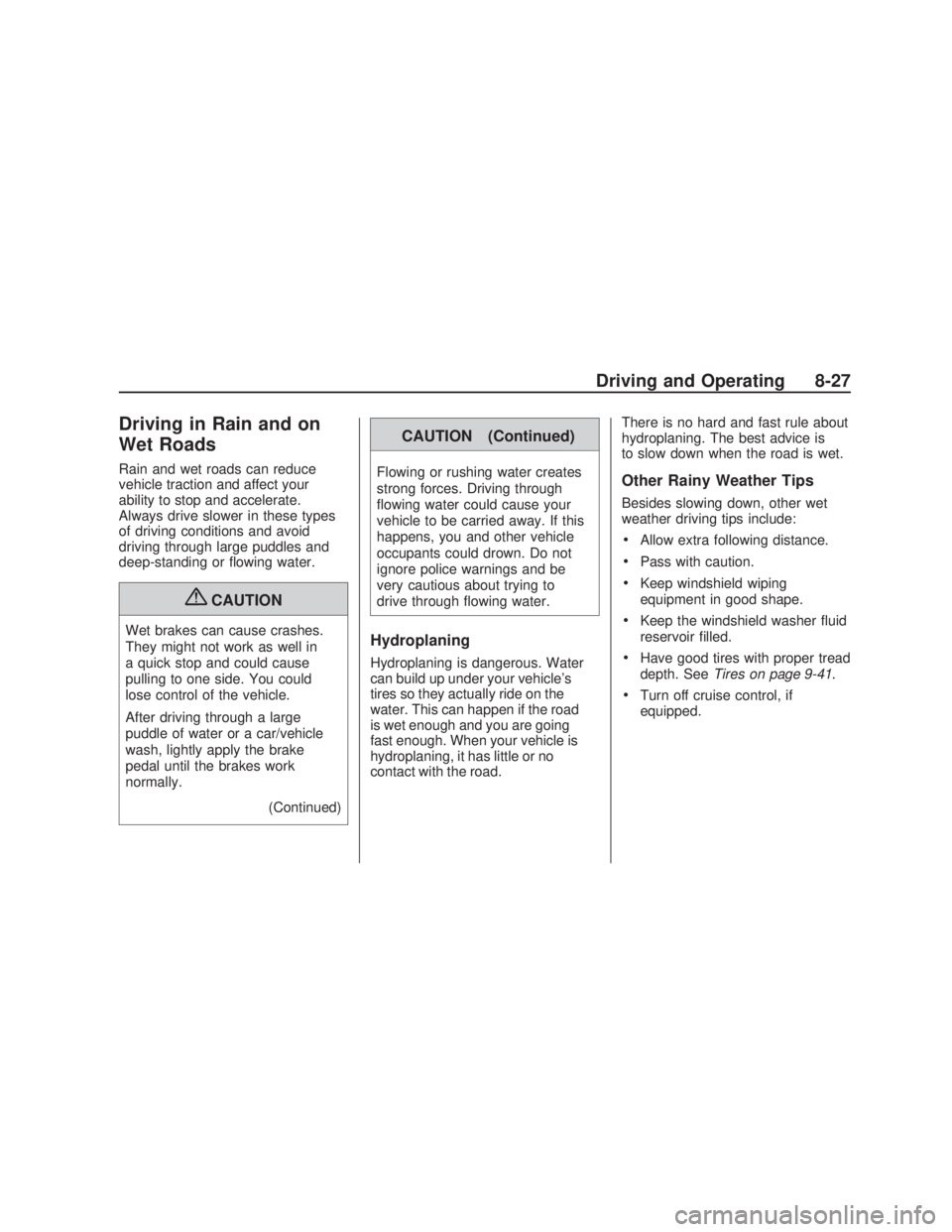
Driving in Rain and on
Wet Roads
Rain and wet roads can reduce
vehicle traction and affect your
ability to stop and accelerate.
Always drive slower in these types
of driving conditions and avoid
driving through large puddles and
deep-standing or �owing water.
{CAUTION
Wet brakes can cause crashes.
They might not work as well in
a quick stop and could cause
pulling to one side. You could
lose control of the vehicle.
After driving through a large
puddle of water or a car/vehicle
wash, lightly apply the brake
pedal until the brakes work
normally.
(Continued)
CAUTION (Continued)
Flowing or rushing water creates
strong forces. Driving through
�owing water could cause your
vehicle to be carried away. If this
happens, you and other vehicle
occupants could drown. Do not
ignore police warnings and be
very cautious about trying to
drive through �owing water.
Hydroplaning
Hydroplaning is dangerous. Water
can build up under your vehicle’s
tires so they actually ride on the
water. This can happen if the road
is wet enough and you are going
fast enough. When your vehicle is
hydroplaning, it has little or no
contact with the road.There is no hard and fast rule about
hydroplaning. The best advice is
to slow down when the road is wet.
Other Rainy Weather Tips
Besides slowing down, other wet
weather driving tips include:
Allow extra following distance.
Pass with caution.
Keep windshield wiping
equipment in good shape.
Keep the windshield washer �uid
reservoir �lled.
Have good tires with proper tread
depth. SeeTires on page 9-41.
Turn off cruise control, if
equipped.
Driving and Operating 8-27
2009 - Pontiac Vibe Owner Manual
Page 214 of 318
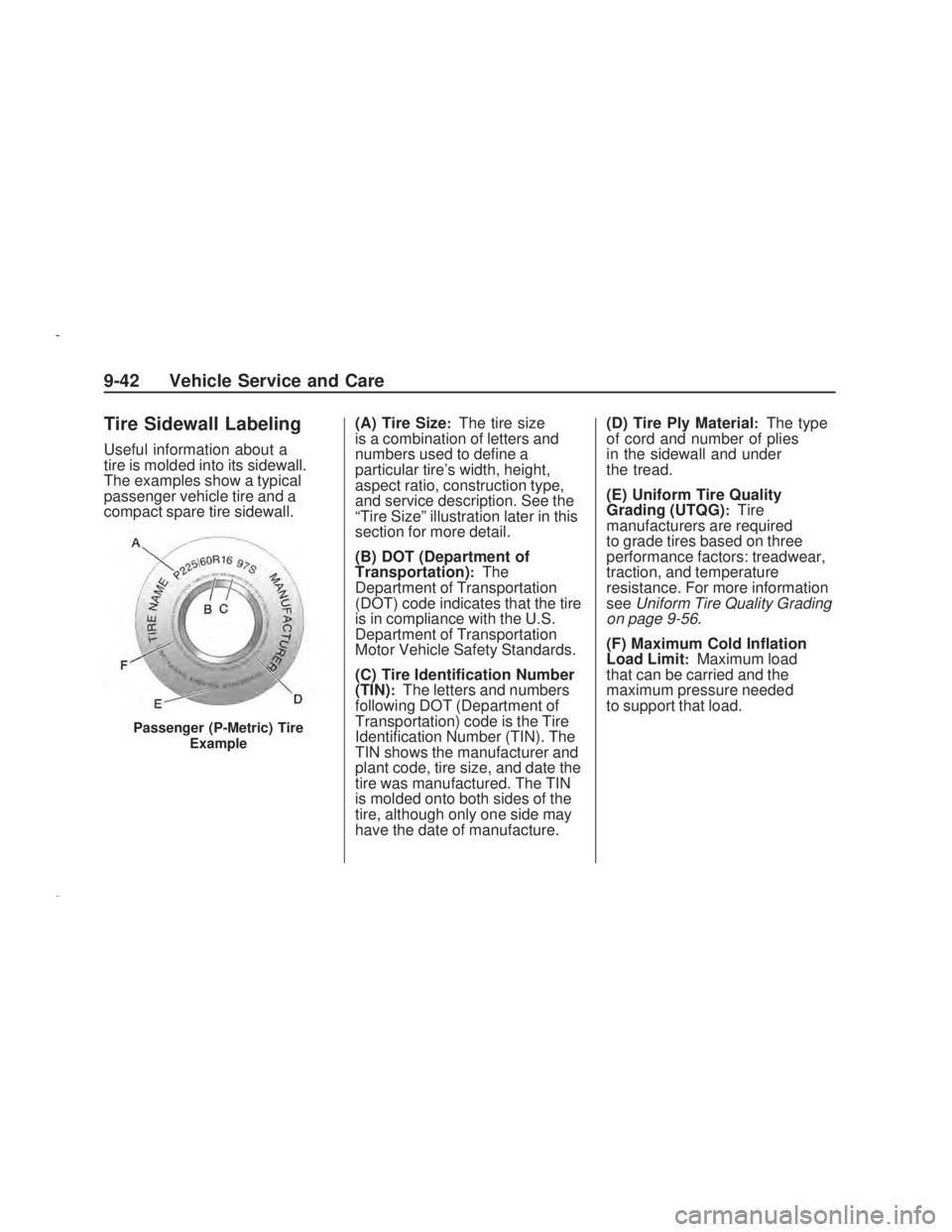
Tire Sidewall Labeling
Useful information about a
tire is molded into its sidewall.
The examples show a typical
passenger vehicle tire and a
compact spare tire sidewall.(A) Tire Size
:The tire size
is a combination of letters and
numbers used to de�ne a
particular tire’s width, height,
aspect ratio, construction type,
and service description. See the
“Tire Size” illustration later in this
section for more detail.
(B) DOT (Department of
Transportation)
:The
Department of Transportation
(DOT) code indicates that the tire
is in compliance with the U.S.
Department of Transportation
Motor Vehicle Safety Standards.
(C) Tire Identi�cation Number
(TIN)
:The letters and numbers
following DOT (Department of
Transportation) code is the Tire
Identi�cation Number (TIN). The
TIN shows the manufacturer and
plant code, tire size, and date the
tire was manufactured. The TIN
is molded onto both sides of the
tire, although only one side may
have the date of manufacture.(D) Tire Ply Material
:The type
of cord and number of plies
in the sidewall and under
the tread.
(E) Uniform Tire Quality
Grading (UTQG)
:Tire
manufacturers are required
to grade tires based on three
performance factors: treadwear,
traction, and temperature
resistance. For more information
seeUniform Tire Quality Grading
on page 9-56.
(F) Maximum Cold In�ation
Load Limit
:Maximum load
that can be carried and the
maximum pressure needed
to support that load.
Passenger (P-Metric) Tire
Example
9-42 Vehicle Service and Care
2009 - Pontiac Vibe Owner Manual
Page 215 of 318
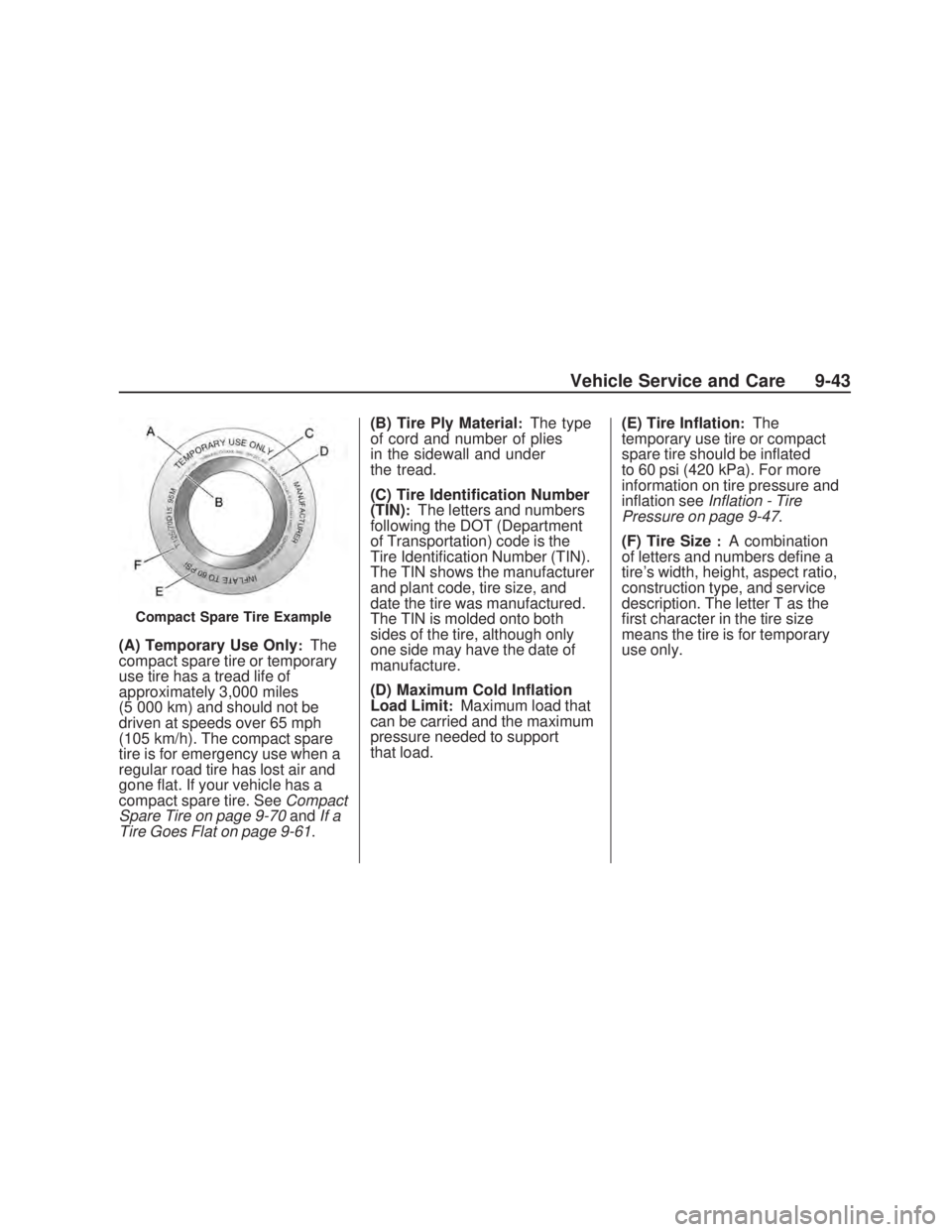
(A) Temporary Use Only:The
compact spare tire or temporary
use tire has a tread life of
approximately 3,000 miles
(5 000 km) and should not be
driven at speeds over 65 mph
(105 km/h). The compact spare
tire is for emergency use when a
regular road tire has lost air and
gone �at. If your vehicle has a
compact spare tire. SeeCompact
Spare Tire on page 9-70andIf a
Tire Goes Flat on page 9-61.(B) Tire Ply Material
:The type
of cord and number of plies
in the sidewall and under
the tread.
(C) Tire Identi�cation Number
(TIN)
:The letters and numbers
following the DOT (Department
of Transportation) code is the
Tire Identi�cation Number (TIN).
The TIN shows the manufacturer
and plant code, tire size, and
date the tire was manufactured.
The TIN is molded onto both
sides of the tire, although only
one side may have the date of
manufacture.
(D) Maximum Cold In�ation
Load Limit
:Maximum load that
can be carried and the maximum
pressure needed to support
that load.(E) Tire In�ation
:The
temporary use tire or compact
spare tire should be in�ated
to 60 psi (420 kPa). For more
information on tire pressure and
in�ation seeInflation - Tire
Pressure on page 9-47.
(F) Tire Size
:A combination
of letters and numbers de�ne a
tire’s width, height, aspect ratio,
construction type, and service
description. The letter T as the
�rst character in the tire size
means the tire is for temporary
use only.
Compact Spare Tire Example
Vehicle Service and Care 9-43
2009 - Pontiac Vibe Owner Manual
Page 216 of 318
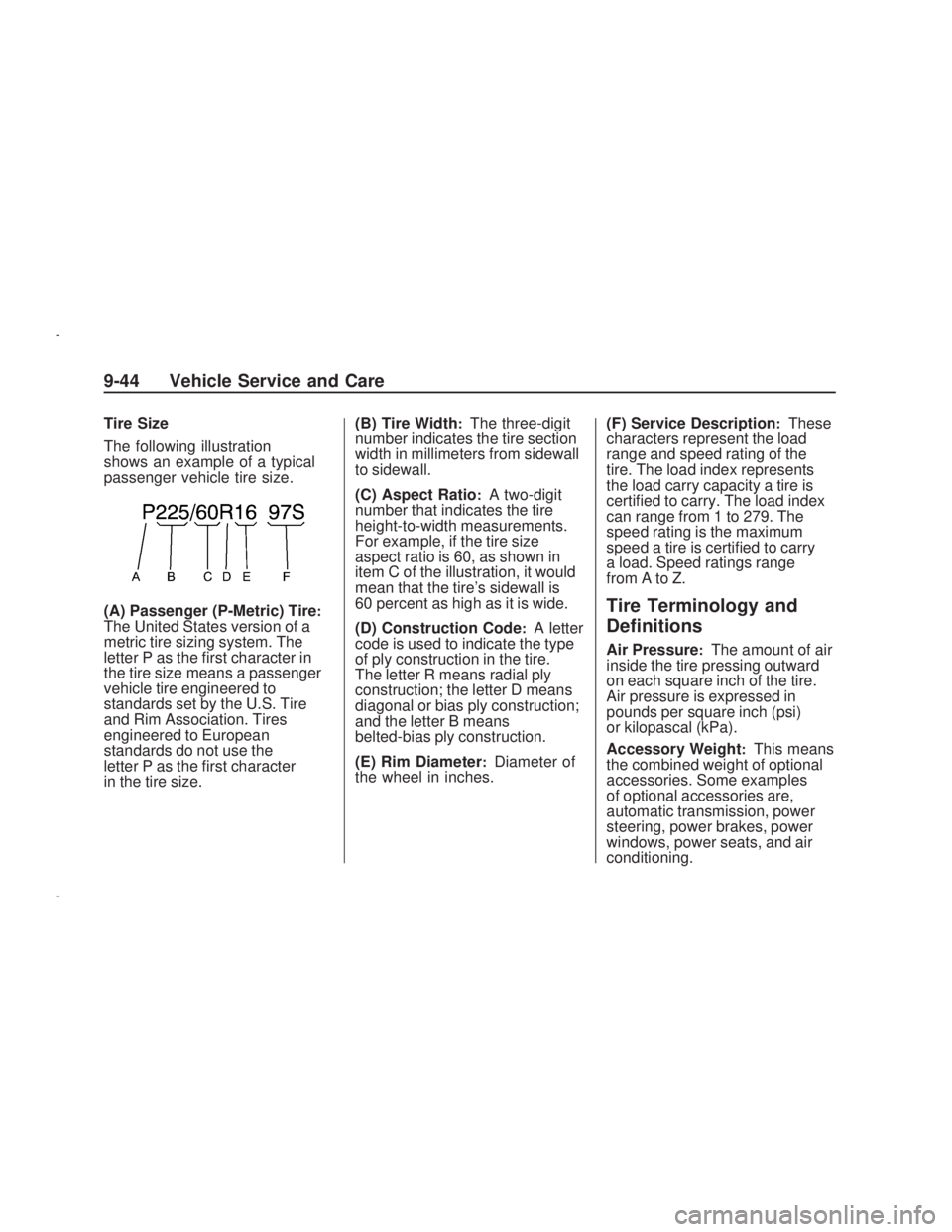
Tire Size
The following illustration
shows an example of a typical
passenger vehicle tire size.
(A) Passenger (P-Metric) Tire
:The United States version of a
metric tire sizing system. The
letter P as the �rst character in
the tire size means a passenger
vehicle tire engineered to
standards set by the U.S. Tire
and Rim Association. Tires
engineered to European
standards do not use the
letter P as the �rst character
in the tire size.(B) Tire Width
:The three-digit
number indicates the tire section
width in millimeters from sidewall
to sidewall.
(C) Aspect Ratio
:A two-digit
number that indicates the tire
height-to-width measurements.
For example, if the tire size
aspect ratio is 60, as shown in
item C of the illustration, it would
mean that the tire’s sidewall is
60 percent as high as it is wide.
(D) Construction Code
:A letter
code is used to indicate the type
of ply construction in the tire.
The letter R means radial ply
construction; the letter D means
diagonal or bias ply construction;
and the letter B means
belted-bias ply construction.
(E) Rim Diameter
:Diameter of
the wheel in inches.(F) Service Description
:These
characters represent the load
range and speed rating of the
tire. The load index represents
the load carry capacity a tire is
certi�ed to carry. The load index
can range from 1 to 279. The
speed rating is the maximum
speed a tire is certi�ed to carry
a load. Speed ratings range
fromAtoZ.
Tire Terminology and
De�nitions
Air Pressure:The amount of air
inside the tire pressing outward
on each square inch of the tire.
Air pressure is expressed in
pounds per square inch (psi)
or kilopascal (kPa).
Accessory Weight
:This means
the combined weight of optional
accessories. Some examples
of optional accessories are,
automatic transmission, power
steering, power brakes, power
windows, power seats, and air
conditioning.
9-44 Vehicle Service and Care
2009 - Pontiac Vibe Owner Manual
Page 220 of 318

When to Check
Check your tires once a month
or more. Do not forget to
check the compact spare tire,
it should be at 60 psi (420 kPa).
For additional information
regarding the compact spare
tire, seeCompact Spare Tire
on page 9-70.
How to Check
Use a good quality pocket-type
gage to check tire pressure.
You cannot tell if your tires are
properly in�ated simply by
looking at them. Radial tires may
look properly in�ated even when
they are under-in�ated. Check
the tire’s in�ation pressure when
the tires are cold. Cold means
your vehicle has been sitting for
at least three hours or driven no
more than 1 mile (1.6 km).Remove the valve cap from the
tire valve stem. Press the tire
gage �rmly onto the valve to
get a pressure measurement.
If the cold tire in�ation pressure
matches the recommended
pressure on the Tire and Loading
Information label, no further
adjustment is necessary. If the
in�ation pressure is low, add air
until you reach the recommended
amount.
If you over�ll the tire, release air
by pushing on the metal stem
in the center of the tire valve.
Re-check the tire pressure with
the tire gage.
Be sure to put the valve caps
back on the valve stems.
They help prevent leaks by
keeping out dirt and moisture.Tire Pressure Monitor
System
The Tire Pressure Monitor System
(TPMS) uses radio and sensor
technology to check tire pressure
levels. The TPMS sensors monitor
the air pressure in your vehicle’s
tires and transmit tire pressure
readings to a receiver located
in the vehicle.
Each tire, including the spare
(if provided), should be checked
monthly when cold and in�ated to
the in�ation pressure recommended
by the vehicle manufacturer on the
vehicle placard or tire in�ation
pressure label. (If your vehicle has
tires of a different size than the size
indicated on the vehicle placard or
tire in�ation pressure label, you
should determine the proper tire
in�ation pressure for those tires.)
9-48 Vehicle Service and Care
2009 - Pontiac Vibe Owner Manual
Page 226 of 318

When It Is Time for New
Tires
Various factors, such as
maintenance, temperatures,
driving speeds, vehicle loading,
and road conditions in�uence
when you need new tires.
One way to tell when it is time for
new tires is to check the treadwear
indicators, which will appear
when the tires have only 1/16 inch
(1.6 mm) or less of tread remaining.You need new tires if any of the
following statements are true:You can see the indicators at
three or more places around
the tire.
You can see cord or fabric
showing through the tire’s rubber.
The tread or sidewall is cracked,
cut, or snagged deep enough to
show cord or fabric.
The tire has a bump, bulge,
or split.
The tire has a puncture, cut, or
other damage that cannot be
repaired well because of the
size or location of the damage.
The rubber in tires degrades over
time, even if they are not being used.
This is also true for the spare tire,
if the vehicle has one. Multiple
conditions affect how fast this aging
takes place, including temperatures,loading conditions, and in�ation
pressure maintenance. With proper
care and maintenance tires typically
wear out before they degrade due to
age. If you are unsure about the
need to replace the tires as they get
older, consult the tire manufacturer
for more information.
Buying New Tires
GM has developed and matched
speci�c tires for the vehicle. If you
need replacement tires, GM strongly
recommends that you get tires that
are the same size, brand, load range,
speed rating, and construction type
(radial and bias-belted tires) as the
vehicle’s original tires. This way, the
vehicle will continue to have tires
that are designed to give the same
performance and vehicle safety,
during normal use, as the original
tires. SeeTire Sidewall Labeling on
page 9-42for additional information.
9-54 Vehicle Service and Care
2009 - Pontiac Vibe Owner Manual
Page 227 of 318
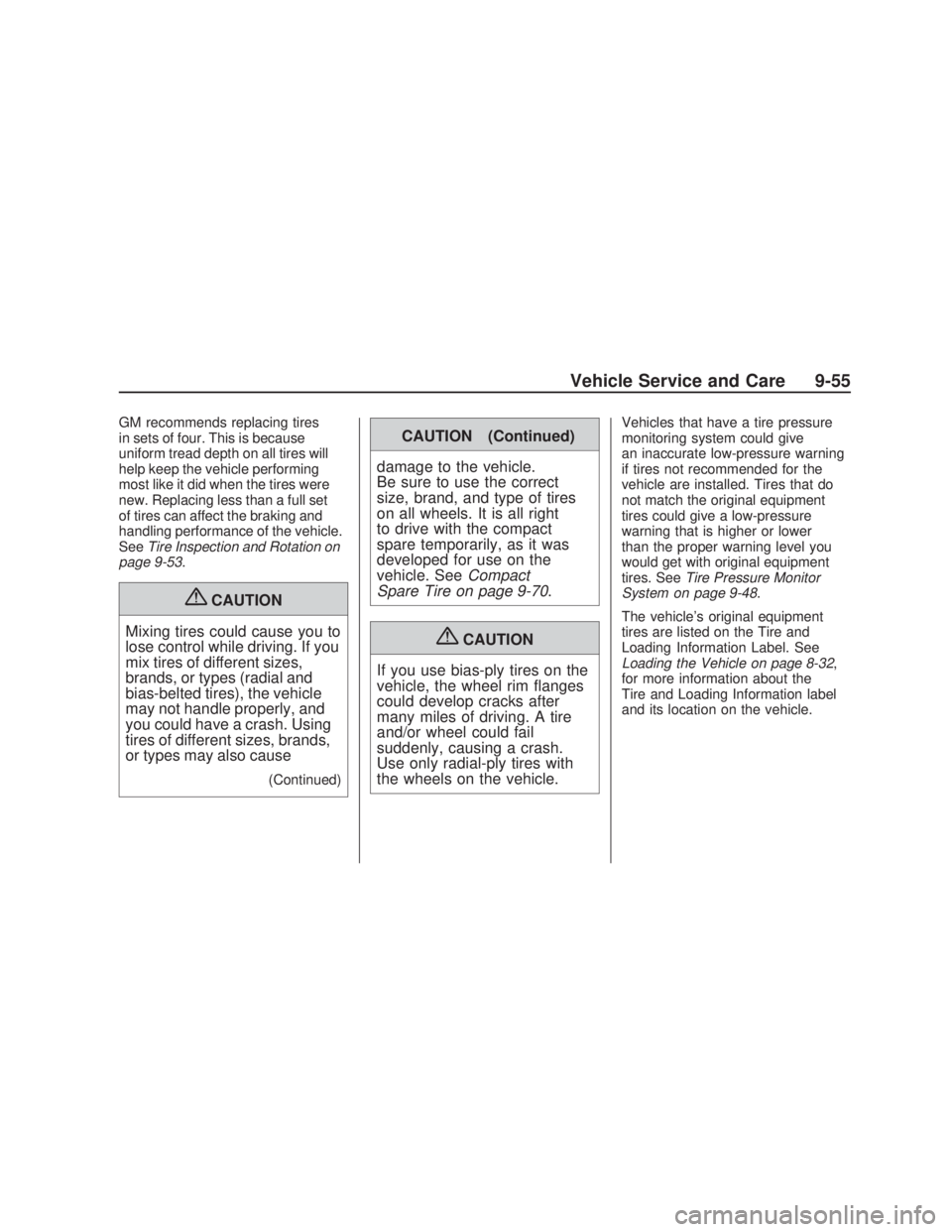
GM recommends replacing tires
in sets of four. This is because
uniform tread depth on all tires will
help keep the vehicle performing
most like it did when the tires were
new. Replacing less than a full set
of tires can affect the braking and
handling performance of the vehicle.
SeeTire Inspection and Rotation on
page 9-53.
{CAUTION
Mixing tires could cause you to
lose control while driving. If you
mix tires of different sizes,
brands, or types (radial and
bias-belted tires), the vehicle
may not handle properly, and
you could have a crash. Using
tires of different sizes, brands,
or types may also cause
(Continued)
CAUTION (Continued)
damage to the vehicle.
Be sure to use the correct
size, brand, and type of tires
on all wheels. It is all right
to drive with the compact
spare temporarily, as it was
developed for use on the
vehicle. SeeCompact
Spare Tire on page 9-70.
{CAUTION
If you use bias-ply tires on the
vehicle, the wheel rim �anges
could develop cracks after
many miles of driving. A tire
and/or wheel could fail
suddenly, causing a crash.
Use only radial-ply tires with
the wheels on the vehicle.
Vehicles that have a tire pressure
monitoring system could give
an inaccurate low-pressure warning
if tires not recommended for the
vehicle are installed. Tires that do
not match the original equipment
tires could give a low-pressure
warning that is higher or lower
than the proper warning level you
would get with original equipment
tires. SeeTire Pressure Monitor
System on page 9-48.
The vehicle’s original equipment
tires are listed on the Tire and
Loading Information Label. See
Loading the Vehicle on page 8-32,
for more information about the
Tire and Loading Information label
and its location on the vehicle.
Vehicle Service and Care 9-55
2009 - Pontiac Vibe Owner Manual
Page 229 of 318
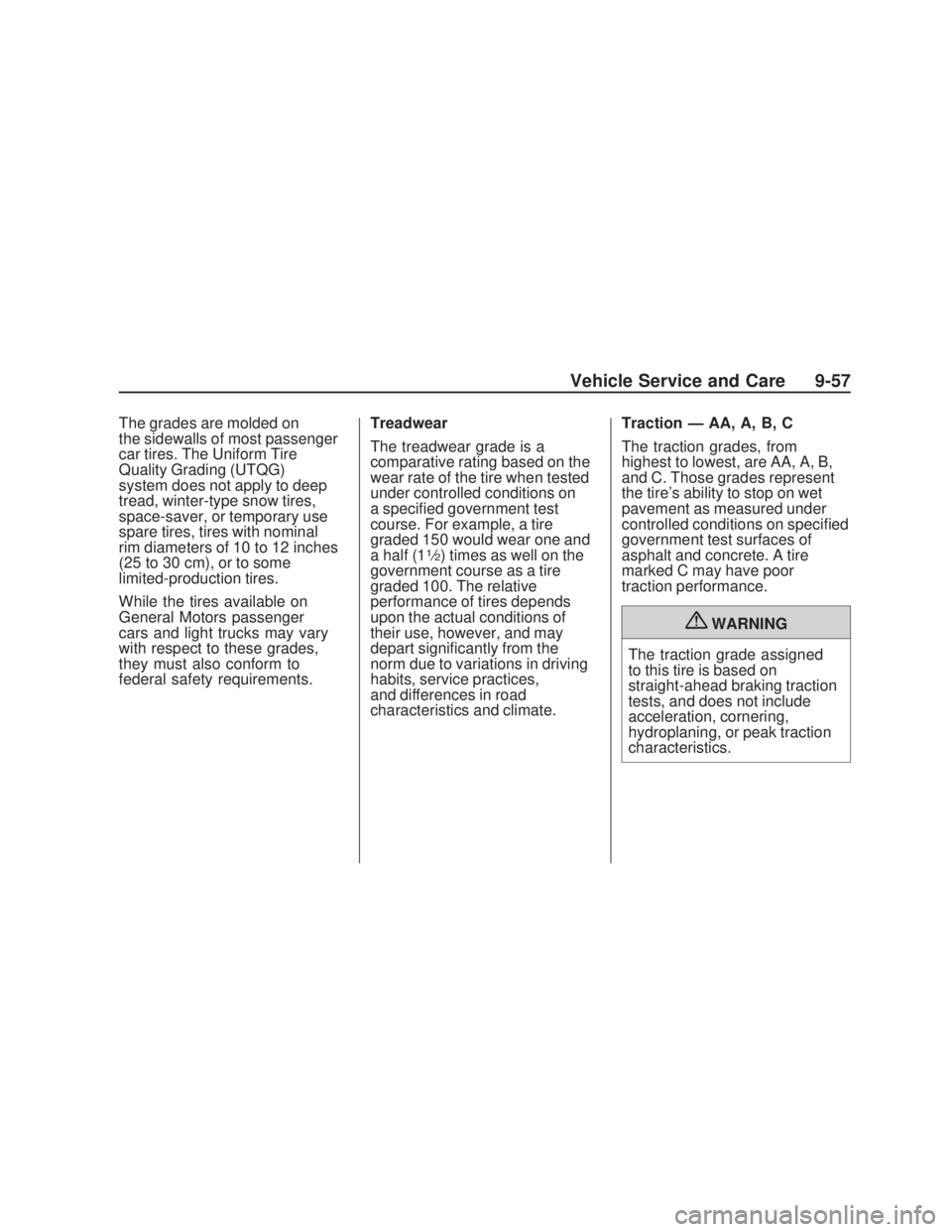
The grades are molded on
the sidewalls of most passenger
car tires. The Uniform Tire
Quality Grading (UTQG)
system does not apply to deep
tread, winter-type snow tires,
space-saver, or temporary use
spare tires, tires with nominal
rim diameters of 10 to 12 inches
(25 to 30 cm), or to some
limited-production tires.
While the tires available on
General Motors passenger
cars and light trucks may vary
with respect to these grades,
they must also conform to
federal safety requirements.Treadwear
The treadwear grade is a
comparative rating based on the
wear rate of the tire when tested
under controlled conditions on
a speci�ed government test
course. For example, a tire
graded 150 would wear one and
a half (1
1�2) times as well on the
government course as a tire
graded 100. The relative
performance of tires depends
upon the actual conditions of
their use, however, and may
depart signi�cantly from the
norm due to variations in driving
habits, service practices,
and differences in road
characteristics and climate.Traction — AA, A, B, C
The traction grades, from
highest to lowest, are AA, A, B,
and C. Those grades represent
the tire’s ability to stop on wet
pavement as measured under
controlled conditions on speci�ed
government test surfaces of
asphalt and concrete. A tire
marked C may have poor
traction performance.
{WARNING
The traction grade assigned
to this tire is based on
straight-ahead braking traction
tests, and does not include
acceleration, cornering,
hydroplaning, or peak traction
characteristics.
Vehicle Service and Care 9-57
2009 - Pontiac Vibe Owner Manual